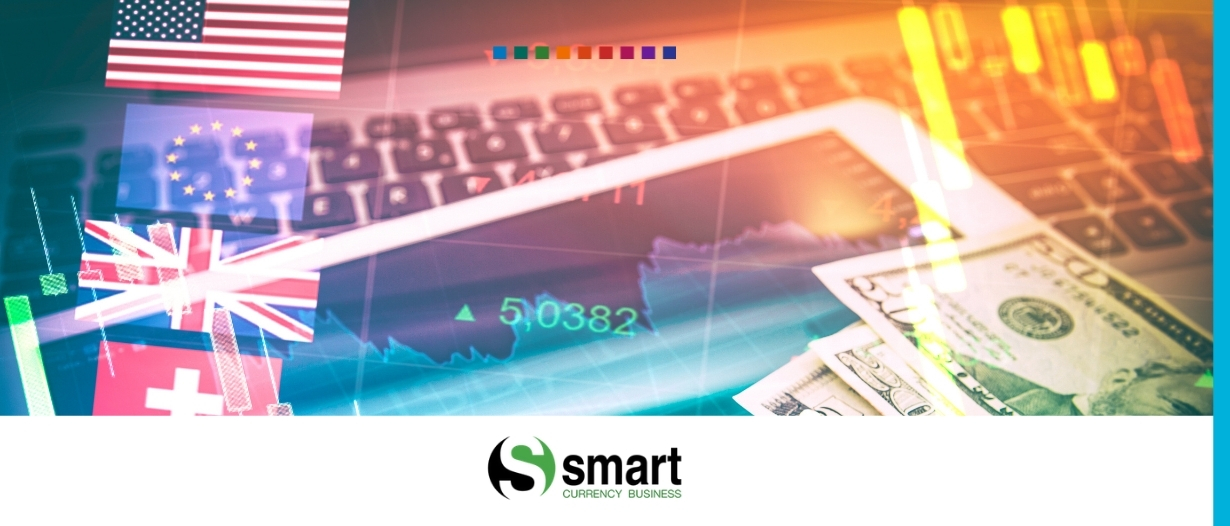Smart Currency Business has collated predictions from major banks and highlighted key factors which may influence the pound, euro and dollar in their latest Quarterly Forecast.

During the first three months of this year, the pound was the best-performing G-10 currency, reaching 3-year highs against the dollar and 13-month highs against the euro. The UK’s successful vaccine programme and the absence of a negative interest rate cut from the Bank of England boosted sterling.
However, the month of April was a slightly different story. With the UK’s vaccine rollout largely ‘priced in’, the pound fell by 2.5% in 8 days against the euro and was volatile, reacting to global risk sentiment. It has since regained some of its strength, but uncertainties remain
So, as we approach summer and the rest of the year, what’s next for the pound?
Can we trust the forecasts?
As we know from the events of the past year, the course of currencies is anything but certain. The pandemic, the economy and a host of other factors determine which way the pound moves and when. No one can predict the course of these events, so no one, not even the experts, can really know where the pound will be by tomorrow, let alone by summer or in 12 months’ time.
Nevertheless, Smart Currency Business have collated predictions from major banks and highlighted key factors which may influence the pound, euro and dollar in their latest Quarterly Forecast. Whilst these predictions may only be educated guesswork, they build into a fascinating guide to the political, economic and, these days, health events that will influence the pound. Download your copy here.
GBP/USD
The most optimistic prediction from the major banks by Q3 is a recovery to $1.49, rising to levels of around $1.53 over the next 12 months. While the majority of leading banks had sterling trading around $1.40 for the coming months, some institutions offer a more modest prediction of around $1.32.
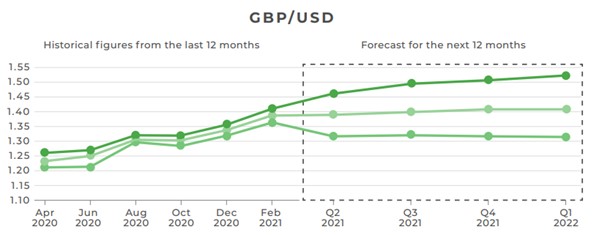
Treasury yields and the Federal Reserve’s stance on monetary policy have impacted the dollar recently and could continue to do so over the next quarter and year.
The Fed left all monetary policy unchanged at their latest monetary policy meeting. Fed Chair Jerome Powell reiterated that it is too soon to start tapering monetary policy, despite signs that the economy is recovering.
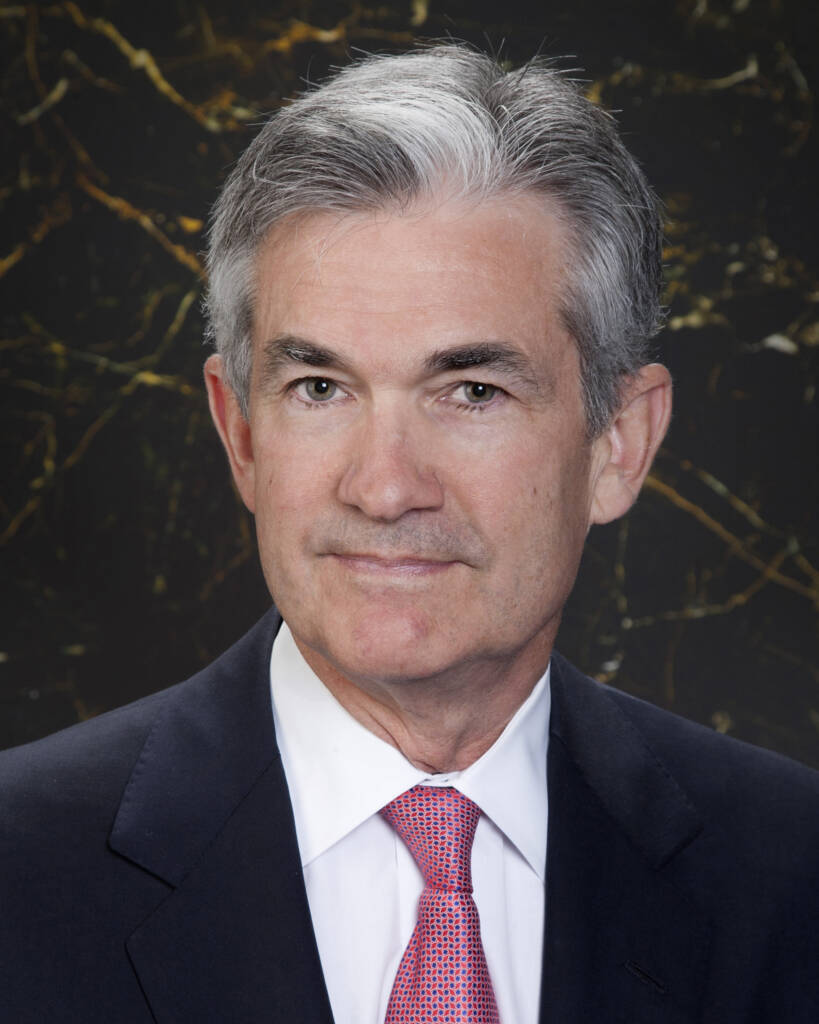
Powell explained that:
“The economy is a long way from our goals and is likely to take some time for substantial further progress to be achieved.”
This ‘dovish’ stance has weighed on the greenback.
Further spending from the Biden administration has already had and will continue to have, a bearing on the US economic recovery. It’s thought that Biden’s huge $1.9 trillion stimulus bill and $2 trillion worth of investment in infrastructure could help economic recovery on a global scale. He also recently revealed further spending plans for jobs, education and social care, coined The American Jobs Plan and the American Families Plan.
GBP/EUR
According to some analysts, GBP/EUR could reach around €1.06 by Q3. Not everyone is quite so pessimistic, however, with predictions stretching as high as €1.21 but settling at an average of around €1.16.
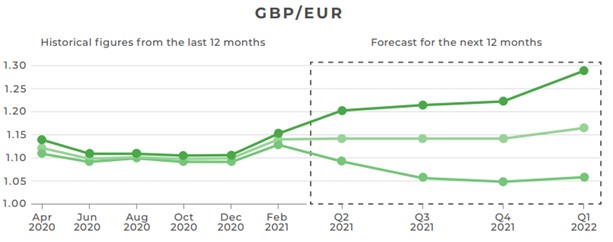
Many analysts think that the UK’s vaccine success is now ‘priced in’ to the markets and the steady progress that Europe has made since the beginning of April is helping the euro.
A risk event for the pound was the Scottish Parliament election at the beginning of May, due to the possibility that this would boost the campaign for Scottish independence. The pound favours stability, so an SNP majority could have spelt volatility for sterling. However, the SNP failed to win an outright majority and sterling strengthened against the euro and dollar as a result.
The future of this pair could be strongly tied to the recovery of the UK and European economies. If the Prime Minister’s ‘roadmap’ to recovery continues successfully, the pound could benefit from this.
EUR/USD
The average prediction for EUR/USD over the next 12 months stays fairly level, around the $1.20 mark. For Q4, the disparity between the highest and lowest predictions widens, with forecasts ranging from 1.14 to 1.37.
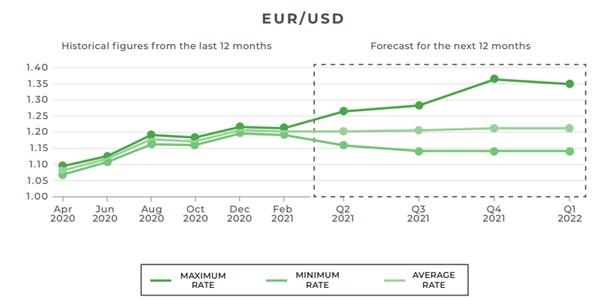
The euro began to strengthen in April after a weak start to the year. It continues to perform well against the dollar, despite Europe’s second wave of COVID-19 infections and the slow pace of its vaccine rollout.
As Europe continues to ease lockdown restrictions and accelerate its vaccine programmes, the euro could benefit further. The European Commission aims to have 70% of all adults vaccinated by the end of June. Any news on tourism in Europe could also impact the euro, as the European economy relies heavily on international visitors during the summer months.
What can you do to protect your business?
As economies begin to recover from the effects of the pandemic, policymakers and central bankers on both sides of the Atlantic continue to face unprecedented challenges. The range of potential outcomes is still broad, so attempting to make any kind of prediction about rates is an impossible task. If you are considering or attempting to base your business budgets or plans on the forecasts, please think twice!
Instead of trying to predict the future, why not protect your business from upcoming currency fluctuations? Smart Currency Business can put a risk management strategy in place, which will ensure that your business is safeguarded against volatility.















